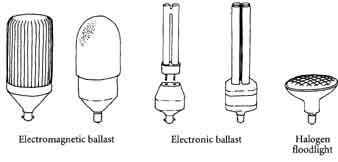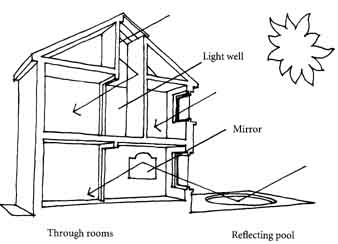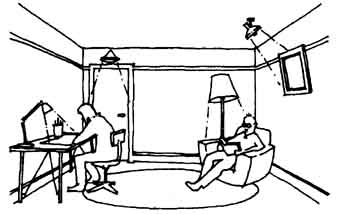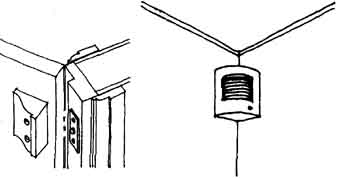We are witnessing a revolution in energy-efficient lighting, one that will make lighting a far smaller proportion of our energy requirements if we use these advances intelligently. Once electrical heating has been reduced to a minimum, lighting accounts for anything from 30% to 70% of the total residential electrical consumption. Lighting therefore is the next priority to tackle, and it is encouraging to know that this is an area where savings can be made much more quickly and easily than in almost any other. So far in this section, save for the use of fans to aid ventilation and the control systems involved in heating, the use of electricity has generally been frowned upon; however, electricity performs the function of lighting with greater efficiency than any other means, except of course the use of direct light from the sun. Nevertheless, because we are dependent on this highly polluting energy source, we should use it with care and respect. There are a number of ways to reduce our energy demand as regards lighting:
• Using energy-efficient light fittings.
• Making the most of sunlight and daylight for general illumination purposes.
• Directing light for our needs (task-directed lighting).
• Controlling our use of light automatically.
• Maintaining peak output from our lights by keeping them clean.
ENERGY-EFFICIENT LIGHT SOURCES
The majority of light fittings in most people’s homes are tungsten incandescent bulbs. However, 90% to 95% of the energy that is consumed by these fittings is converted into heat, with only 5% to 10% being emitted as light. How can such a basic inefficiency be reduced? There are two ways that light is emitted from the normal range of domestic light fittings:
• Incandescent light from a tungsten filament
• Fluorescent light from an excited phosphor coating
Fluorescent light, however, is four to five times more efficient than incandescent light! Both these systems of producing light have undergone recent technical improvements which we are only just beginning to make full use of domestically. They will now be examined in more detail.
Fluorescent Lights
Fluorescent lights have a bad reputation. For many, the long tube that emits a bluish-white light that flickers and buzzes reminds them of dull, unattractive environments. However, many of the limitations of fluorescent lights are now being overcome.

Types of light fittings: Electromagnetic ballast;
Electronic ballast; Halogen floodlight
Fluorescent lights and tungsten filament bulbs work in entirely different ways. The fluorescent tube contains a special gas at low pressure.
‘When an arc is struck between the lamp’s electrodes, ultraviolet radiation is produced from the collision between the electrons in the arc and the atoms in the gas. This ultraviolet light impinges on a phosphor coating on the inside of the tube and excites it, producing light at visible wavelengths. The quality of light that is produced depends on the precise mix of phosphors in the coating: some produce a full-spectrum light akin to daylight, while others mimic tungsten lights, producing a reddish-yellow color. All fluorescent lights require a ballast to operate in addition to the tube. The ballast regulates the voltage and current and is essential for the lamp to operate properly. Each different model of lamp requires a different electronic input and hence requires a ballast specifically designed to drive it. The core-coil ballast, which has been the standard since fluorescent lighting was first developed, uses electromagnetic technology. The electronic ballast, only recently developed, uses solid-state technology.
Compact Fluorescent Lights (CFLs)
In the past, fluorescent fittings were confined to long tubes. New technology has shrunk these tubes so that they are now like small cylindrical fingers protruding from a slightly enlarged bulb base. These compact fluorescent “bulbs” are now being developed to replace every tungsten filament application. It is only a question of how long this process of substitution will take.
Although there may still be some uses for the old fluorescent tubes, it is the new compact fluorescent fittings with electronic ballasts which will be of main interest to homeowners. These electronic ballasts have several advantages. Standard fluorescent lights flicker at 60 cycles per second, which has proved a problem for some people, producing headaches and nausea in certain situations. However, electronically ballasted fittings oscillate at more than 20,000 cycles per second, far faster than the eye can detect. They are also one-third more efficient than the electromagnetic ballasts and come on almost instantly. Dimming options are being developed for this type of bulb, which will never be possible for the old electromagnetic type.
These new lamps present us with a wonderful opportunity to light our homes with a quarter of the energy required before. Virtually all tungsten fittings should be replaced with compact fluorescent fittings as the opportunity arises. Although they cost more than traditional bulbs, you will start seeing savings in your electricity bill right away. These lamps fit into the same sockets as your normal light bulbs and give you a warm-colored light similar to tungsten fittings; they are generally four to five times as efficient as incandescents and last five to ten times as long. Install these first where they are used most: in your living areas and circulation areas that you like to have lit more continually. When cold they take a minute or so reach their full brightness. There are special bulbs for cold outdoor conditions.
Incandescent Tungsten Filament Lighting
Incandescence literally means light produced from a heated object. In light- bulbs, this heating is achieved by passing an electrical current through the thinnest strand or filament that can support itself. The filament is delicate and gradually blackens, eventually burning out. The electric light bulb is thus just one step removed from the gas mantle.
Quartz Halogen Lights
These are the latest souped-up models of the tungsten filament lamp. They produce a brighter, whiter light and are more energy-efficient than regular light bulbs because they operate their tungsten filaments at higher temperatures. What is more, the blackening of the filament that occurs in standard bulbs, reducing their output by 25%, has been largely overcome in quartz halogen bulbs, and the light they produce decreases by less than 10% over the lifetime of the fitting.
All this has been achieved by enclosing the filament in a quartz envelope that withstands the heat better than glass, and this envelope has been filled with a halogen gas. When the lamp is operated, particles that evaporate from the filament combine with this gas and are re-deposited back on the filament when the lamp is turned off. This process both reduces the blackening and extends the life of the filament. Where halogen lamps are used with dimmers, these need to be turned on full from time to time to allow this regenerative process to take place. It is important never to touch the quartz envelope with your bare fingers, as the natural oils in your hand will react with the quartz glass and cause it to fail. Often this quartz envelope is enclosed within a larger bulb to prevent just such an occurrence.
Tungsten-halogen lamps produce about 50% to 100% more light per watt than standard tungsten filament bulbs and last longer. Depending on the model the bulb’s expected lifetime could range anywhere from 2,000 to 4,000 hours.
Many models of quartz-halogen bulb operate at 12 volts, which means they require a transformer. These are now quite neat and small, so don’t be put off by this. The main drawback of these lamps is their cost, but their energy-saving quality more than makes up for this. They do give off a very attractive sparkly light; their main advantage is that their light can be focused and directed better than any other light source. This makes them particularly appropriate and efficient for task lighting.
Long-Life Bulbs
These bulbs have been around for a long time and are at the moment being advertised as the latest thing. However, they are very similar to existing bulbs, except that they have a thicker filament and incorporate a special gas in the bulb which makes them last up to four times longer. The irony is that, instead of using less energy, they often use more to produce the same amount of light. They have their place, perhaps in relatively inaccessible fittings, but not in normal domestic circumstances. So don’t buy these bulbs if you want to save energy.
Lifetime and Efficiency Comparisons:
|
Efficiency (lumens per watt) |
Lifetime (hrs) |
Standard incandescents Long-life incandescents Quartz-halogen Compact fluorescents |
1,000 3,000 2,500 7,500 |
13 12 24 60 |
MAXIMIZING OUR USE OF DAYLIGHT
How can we make the very best use of sunlight and daylight—the one free source of light that is available to us? It is useful to remember that daylight, when entering through a standard-sized, unimpeded window during the middle of the day, can supply the lighting equivalent of between five and thirty 100-watt bulbs.

Optimizing the use of daylight: Reflecting pool;
Through rooms
Daylight and sunlight are very important factors in providing a healthy home that is not over reliant on artificial light. The most important means of achieving this is through windows, but in existing housing we are limited by the size and position of existing windows. There follows a list of measures that we can take, showing that there is often a lot we can do to affect daylight levels in any particular room in our home:
• Inside the house, use a light-colored paint or wallpaper on the walls to make the most of any daylight entering the room. Avoid dark carpets, dark-colored furnishings, or other dark floor coverings. Even the use of carefully placed mirrors, reflective louvers, or blinds can bounce the sun’s light deeper into a room.
• Outside the house, ensure that as much light as possible travels through the windows by painting the reveals and frames white and thinking of any other ways of reflecting light inside, such as using reflective surfaces on a path outside or painting adjacent garden walls white. Even a pond will reflect light in through a window. You can also reduce any obstructions that might be overshadowing your windows: foliage might need cutting back, trellises removed, etc. Curtains can be kept away from windows by using longer tracks or curtain ties to hold them back. Don’t forget to keep glass clean, as this can reduce incoming light considerably, even without our realizing it.
• Look at areas of your home that have little daylight or sunlight to see if there are any alterations that will improve this situation. You may consider increasing the height of windows if major renovations are being carried out, or adding roof lights. As a rule of thumb, if you can see the sky, you are probably receiving sufficient daylight at the point where you are standing. Light wells through the roof are very effective if there is unused roof space above a poorly lit room. Skylights admit considerably more light than vertical windows. Another radical alternative is to consider opening up the center of the house and bringing a light well down into it to provide illumination.
• Another way to make the most of daylight is to arrange rooms around the house to make use of the sun’s path across the sky. In spring and autumn we can make the most of daylight hours by going to bed and getting up earlier. We can also choose to work or read wherever daylight is most available.
• Too much light can also be a problem by causing uncomfortable glare. You will need to weigh the conflicting considerations of outlook, visual comfort, and the admission of daylight. Glare can be moderated with Venetian blinds or light curtains.
DIRECTING LIGHT TO WHERE IT IS REQUIRED
There are three different types of light that are referred to by lighting designers:
• General: for example, a central hanging light
• Task lighting: for example, a desk lamp
• Atmospheric or ornamental: for example, a spotlight on a picture
The most important principle of energy-efficient lighting design is to make the most of any light sources available, and direct the light to where it is most required, either for a particular task or for effect. Often we will have a whole room lit to a reasonably bright level or even the whole house lit, and yet we find ourselves working away with barely enough light for the task in hand, be it reading, sewing, or writing. This is clearly an inefficient use of resources, yet many of us do it unconsciously. It is also possible to produce exciting or soothing environments determined by the fittings chosen and the way these are directed. Here are a few guidelines that can help you with getting your lighting right:

Directing light where required
• Think carefully which lights you really need or whether it is possible to reduce the wattage of any light fittings. Also, use bulbs appropriate to the fitting/fixture. In a recessed or spot fixture, a reflector lamp of half the wattage delivers the same amount of light obtained from an ordinary bulb.
• Use task lights. Decide what you really need the light for, then design your lighting scheme. Provide reading lamps where you need to see detail. Reduce your background lighting levels with lower-wattage bulbs to save energy and create more contrast in a room. The ultimate in task lighting is the miner’s helmet, which shines a light at whatever the head is pointed to. For some activities this might even be the most appropriate solution.
• Light for safety. Light outside steps with low-level lights and do the same with inside stairs at night. Place a small light near the keyhole of an external door.
• Light for effect. Use a dimmer switch with a halogen lamp as an energy-efficient way of varying lighting. Highlight the best features of your house and , if you have special high-wattage decorative lights in your home, use them sparingly on special occasions. These are all ways that lighting can make your home more attractive. Light coming from multiple directions is also more attractive than light coming from only one direction. Have some fun with special effects, such as mirrors to multiply the images; or use a light inside a glazed hole in the floor to light both up and down at the same time—say, on the landing of a stairway.

A light in a hole in the floor
CONTROLLING LIGHT
As with all things electric, there is the possibility of all manner of controls that can make systems more efficient by providing light only when and where it is needed. This is mainly achieved by infrared sensing of a person’s presence. These systems have been developed and used for outdoor security purposes, but they are increasingly being used in commercial and institutional environments as well to save energy. Domestic applications will follow as the cost of these controls comes down. The most common present domestic application is that of external lights activated by infrared sensor (motion-detecting floodlights).

Cupboard door switch; Infrared sensor
It may be some time before all our lighting is on automatic, and , in the meantime, we must rely on our little grey memory cells! However, there are two things we can do to help:
• Make sure every light has its own switch so that only lights that are needed are on.
• Put switches in convenient places to encourage the turning on and off of lights as often as is required.
PRIORITIES FOR ACTION
• Use energy-efficient lamps wherever possible, changing the bulbs in the most often used locations first.
• Use lighting only when and where it is needed.
• When setting up task lighting, remember that you need only use a low-wattage lamp if it is positioned close to where light is required.
• Use tungsten halogen bulbs sparingly to add sparkle to selected locations.
• Make the very most of your daylight potential by reflecting as much light as possible into your home, reducing obstructions.
• Use controls such as timers and infrared switches where appropriate to save energy. Install contact switches (like those used in refrigerators) on doors to lighted cupboards and closets.
• Keep your bulbs and tubes dusted to maintain light out put. Accumulated dirt has a significant shading effect.
• Consider altering your waking day as far as possible to harmonize more closely to sunrise and sunset, particularly in spring and autumn.
Next: Appliances
Prev: Water Heating